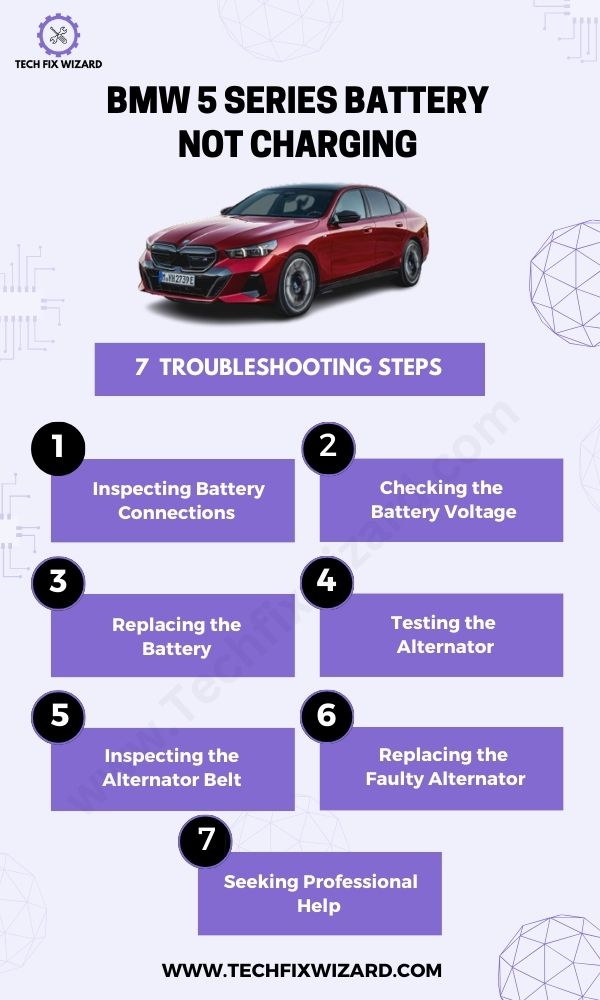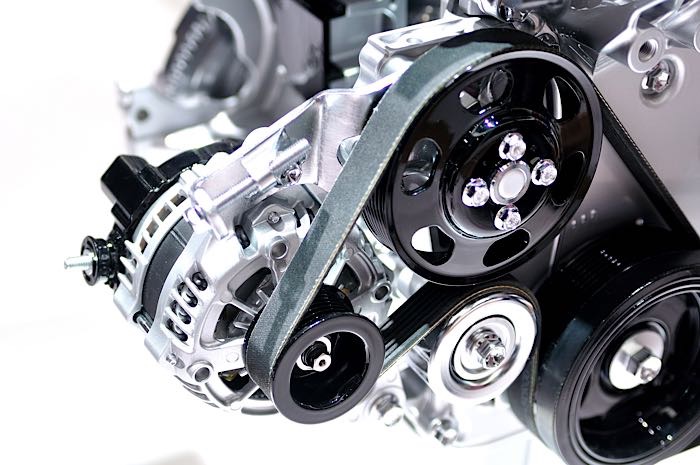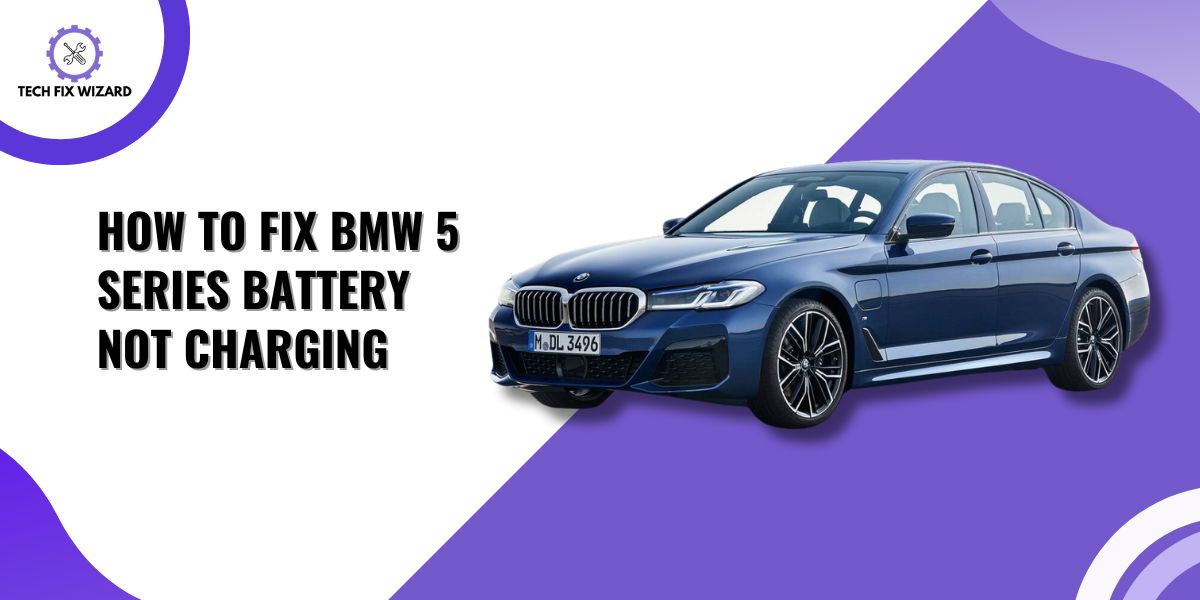Are you having trouble with your BMW 5 Series battery not charging?
This can be a frustrating and potentially dangerous problem, especially if you rely on your vehicle for daily transportation.
Fortunately, there are several steps you can take to diagnose and fix the issue.
In this article, we will guide you through the process of identifying the symptoms of a BMW 5 Series battery not charging and suggest steps to troubleshoot this issue.
Contents
- 1 BMW 5 Series Battery Not Charging – Symptoms
- 2 BMW 5 Series Battery Not Charging – 7 Troubleshooting Steps
- 3 1. Inspecting the Battery Connections
- 4 2. Checking the Battery Voltage
- 5 3. Replacing a Dead or Dying Battery
- 6 4. Testing the Alternator
- 7 5. Inspecting the Alternator Belt
- 8 6. Replacing the Faulty Alternator
- 8.1 1. Prepare for the Replacement:
- 8.2 2. Disconnect the Battery:
- 8.3 3. Locate the Alternator:
- 8.4 4. Disconnect Electrical Connections:
- 8.5 5. Loosen the Drive Belt:
- 8.6 6. Remove Mounting Bolts:
- 8.7 7. Detach the Alternator:
- 8.8 8. Compare and Install the New Alternator:
- 8.9 9. Reconnect Electrical Connections:
- 8.10 10. Tighten the Drive Belt:
- 8.11 11. Reconnect the Battery:
- 8.12 12. Test and Verify:
- 9 7. Seeking Professional Help
- 10 Preventative Maintenance to Avoid Future Problems
- 11 FAQs
- 12 Why is my BMW 5 Series battery not charging?
- 13 How can I determine if my BMW 5 Series battery is not charging?
- 14 What should I do if my BMW 5 Series battery is not charging?
- 15 Can a dead battery cause the BMW 5 Series not to charge?
- 16 How often should I replace the battery in my BMW 5 Series?
- 17 Can I replace the BMW 5 Series battery myself?
- 18 How much does it cost to replace a BMW 5 Series battery?
- 19 How long does it take to replace a BMW 5 Series battery?
- 20 Can a faulty alternator cause the battery not to charge in a BMW 5 Series?
- 21 What are some signs of a failing alternator in a BMW 5 Series?
- 22 Official References & Resources
BMW 5 Series Battery Not Charging – Symptoms
If your BMW 5 Series is acting like it’s too tired to climb the hill, it might be a sign that the battery isn’t charging properly.
Several symptoms can indicate a problem with your car’s battery.
- Illuminated battery warning light on the dashboard (red lightning bolt symbol or yellow battery symbol)
- Difficulty starting the engine (clicking sounds or no response)
- Dim or weak headlights and electrical components
- Reduced fuel efficiency and increased fuel consumption
BMW 5 Series Battery Not Charging – 7 Troubleshooting Steps
When faced with a BMW 5 Series battery not charging, it is essential to follow troubleshooting steps to pinpoint and resolve the underlying issue.
By going through a systematic process, you can identify potential causes and take appropriate action.
Let’s embark on a journey into the world of troubleshooting!

Also Read: BMW 1 Series Battery Not Charging – 8 Practical Steps To Try
1. Inspecting the Battery Connections
One of the first steps in troubleshooting a BMW 5 Series battery not charging is to inspect the battery connections.
Over time, battery terminals can become loose or corroded, impeding the flow of electricity.
To inspect the battery connections:
- Pop open the hood and visually inspect the metal clamps attaching to the battery terminals.
- Check for any corrosion or looseness on the connections.
- Clean corrosion by using a wire brush or sandpaper to scrub it away.
- Tighten the nuts on the clamps using pliers if there is any looseness.
- Look for frayed or damaged wires connected to the battery and replace them if necessary.
- Ensure all cables are properly connected and not loose.
2. Checking the Battery Voltage
The next step in troubleshooting a BMW 5 Series battery not charging is to check the battery voltage. This will help determine if the battery has sufficient power or if it needs to be replaced.
- Set the voltmeter to DC voltage, ensuring it is set to at least 20 volts.
- Turn off all electronics in the car.
- Connect the positive lead of the voltmeter to the positive terminal of the battery.
- Connect the negative lead of the voltmeter to the negative terminal of the battery.
- Check the voltage reading, which should be between 12.4-12.7 volts for a fully charged battery.
- If the voltage falls below this range or reads less than 11 volts, the battery may be dead or dying.
- If uncertain about the battery’s condition, try jump-starting it with another vehicle or a portable jump starter kit.
- If jump-starting doesn’t work, consider replacing the battery.

3. Replacing a Dead or Dying Battery
If you determine that your BMW 5 Series battery requires replacement based on the troubleshooting steps mentioned earlier, it’s time to proceed with the battery replacement process.
Follow the steps outlined below to safely and effectively replace your battery.
1. Safety First:
Ensure the engine is turned off to prevent any accidental electrical shocks. Put on safety gloves and goggles to protect yourself from potential hazards, such as corrosive battery acid.
2. Locate the Battery:
Open the trunk of your BMW 5 Series and remove any trunk floor covers or access panels that may be covering the battery compartment.
Take a moment to visually locate the battery within the compartment. It is typically a rectangular-shaped box with two terminals on the top.
3. Disconnect the Battery:
Start by disconnecting the negative terminal (marked with a “-” sign) followed by the positive terminal (“+”). To do this, loosen the terminal clamps using a wrench or pliers and carefully remove them from the battery posts.
Be cautious not to let the terminals touch any metal surfaces or each other.
4. Remove the Old Battery:
Depending on the battery mounting method, you may need to remove any hold-down clamps or brackets that secure the battery in place.
Once the clamps or brackets are removed, lift the old battery out of its compartment and set it aside.
5. Clean the Battery Compartment:
Before installing the new battery, it’s important to clean the battery compartment. Use a battery-cleaning brush or a damp cloth to remove any debris or corrosion from the compartment.
Pay close attention to the area around the battery terminals.
6. Install the New Battery:
Carefully place the new battery into the compartment, ensuring the positive and negative terminals align with the correct cables.
Make sure the battery is sitting securely in the compartment.
7. Reconnect the Battery:
Begin by connecting the positive terminal (“+”) first, followed by the negative terminal (“-“). Slide the terminal clamps onto the battery posts and tighten them securely using a wrench or pliers.
Ensure the clamps are snugly attached to the terminals.
8. Test the New Battery:
Start the vehicle and observe if the battery warning light on the dashboard is no longer illuminated. Check that all electrical systems, such as lights and radio, are functioning properly.
This indicates that the new battery is properly installed and functioning correctly.
Also Read: BMW 3 Series Battery Not Charging – 7 Solutions You Can Try
4. Testing the Alternator
Testing the alternator is an important step in resolving a BMW 5 Series battery not charging issue. The alternator is responsible for charging the battery while the engine is running.
- Turn on the car and let it run for a few minutes.
- Use a voltmeter to check the voltage at the battery terminals.
- If the voltage reading is below 13 volts, it may indicate an issue with the alternator.
- Pay attention to any unusual noises or smells coming from the alternator while the engine is running.

5. Inspecting the Alternator Belt
The alternator belt is responsible for transferring power from the engine to the alternator, allowing it to generate electricity and charge the battery.
If the belt is worn, loose, or damaged, it can affect the charging capability of the alternator. Follow the steps below to inspect the alternator belt:
1. Preparation:
- Ensure the engine is turned off and the car is parked in a safe location.
- Put on safety gloves and goggles for protection.
2. Locate the Alternator Belt:
- Open the hood of your BMW 5 Series and locate the alternator, which is usually located near the front of the engine.
- Identify the serpentine belt that is connected to the alternator. It is a long belt that wraps around various pulleys in the engine compartment.
3. Inspect the Belt Tension:
- Check the tension of the belt by pressing down on it with your finger.
- The belt should have firm and consistent tension. If it feels loose or has excessive play, it may need to be tightened or replaced.
4. Check for Belt Wear:
- Examine the belt for signs of wear, such as cracks, fraying, or glazing on the surface.
- If you notice any significant wear, it is recommended to replace the belt as soon as possible.
5. Check for Belt Alignment:
- Inspect the alignment of the belt on the pulleys.
- The belt should be properly aligned, without any misalignment or slipping off the pulleys.

Similar Read: BMW 7 Series Battery Not Charging – 6 Troubleshooting Steps
6. Replacing the Faulty Alternator
Replacing the alternator is an involved process and should be done with caution. It is recommended to have a professional mechanic perform this task.
However, if you have the necessary skills and tools, here is the outline of the steps involved in replacing the alternator in the BMW 1 Series:
Replacing the alternator in your BMW 1 Series involves several steps. Here’s a general guide:
1. Prepare for the Replacement:
Ensure the vehicle is turned off and parked in a safe location. Put on safety gloves and eye protection.
2. Disconnect the Battery:
Locate the battery in your vehicle and disconnect the negative (-) terminal first, followed by the positive (+) terminal.
This step is important to prevent any electrical mishaps during the alternator replacement.
3. Locate the Alternator:
The alternator is typically located near the engine. Refer to your vehicle’s manual or consult a repair guide specific to your BMW 1 Series model for the exact location.
4. Disconnect Electrical Connections:
Identify and disconnect all electrical connections attached to the alternator. These may include wiring harnesses, plugs, and connectors.
Take note of their positions or take pictures for reference during reassembly.
5. Loosen the Drive Belt:
Using a wrench or a belt tensioner tool, loosen the tension on the drive belt connected to the alternator.
This will allow you to remove the belt from the alternator pulley.
6. Remove Mounting Bolts:
Locate and remove the mounting bolts that secure the alternator to the engine or bracket.
Depending on the design, there may be one or more bolts to remove. Keep track of the bolts for reinstallation.
7. Detach the Alternator:
Once the mounting bolts are removed, carefully lift and detach the alternator from its mounting position.
Pay attention to any additional brackets or components that may be attached to the alternator.
8. Compare and Install the New Alternator:
Compare the new alternator with the old one to ensure they match in terms of specifications and mounting points.
Install the new alternator in the reverse order of removal, securing it with the mounting bolts.
9. Reconnect Electrical Connections:
Attach the electrical connections to the new alternator, ensuring they are properly connected and secured.
Double-check the wiring harnesses, plugs, and connectors to ensure they are in their correct positions.
10. Tighten the Drive Belt:
Use a wrench or belt tensioner tool to apply tension to the drive belt and ensure it is properly aligned on the alternator pulley.
Refer to the vehicle’s manual for the appropriate tensioning specifications.
11. Reconnect the Battery:
Reconnect the positive (+) terminal first, followed by the negative (-) terminal, to restore power to the vehicle’s electrical system.
12. Test and Verify:
Start the engine and test the new alternator for proper operation. Verify that the battery is charging correctly, and check for any warning lights or abnormal noises.
If everything functions as expected, the alternator replacement is successful.
7. Seeking Professional Help
If you have followed the troubleshooting steps mentioned earlier and are still experiencing issues with your BMW 5 Series battery not charging, it is recommended to seek professional help or contact BMW support for assistance.
An automotive technician with expertise in BMW vehicles will have the necessary tools, knowledge, and diagnostic equipment to identify and resolve complex electrical issues.
Preventative Maintenance to Avoid Future Problems
To keep your BMW 5 Series running smoothly and avoid potential battery-related issues, consider the following preventative measures:
- Schedule Regular Maintenance: Make sure to schedule routine maintenance appointments with a certified mechanic or BMW service center.
- Drive Regularly: Regularly driving your car helps keep the battery charged. If you leave your BMW 5 Series idle for extended periods, the battery can lose its charge and eventually fail.
- Minimize Use of Electronics When Engine is Off: Avoid using electronic devices or accessories, such as infotainment systems or phone chargers, when the engine is off.
- Be Mindful of Electrical Component Usage: While driving, be conscious of your use of electrical components. Avoid leaving interior lights on for extended periods and minimize the use of high-powered sound systems without turning on the engine.
By adopting these proactive steps and prioritizing the health of your BMW 5 Series’ electrical system, you can prolong the life of your battery and minimize the likelihood of future charging issues.
People Also Liked:
- BMW Not Charging Phone – 6 Quick Fixes
- BMW Bluetooth Not Working – Quick Fixes
- BMW Cigarette Lighter Not Charging – 4 Causes & 6 Step Solution
FAQs
Why is my BMW 5 Series battery not charging?
There can be several reasons for a BMW 5 Series battery not charging. Common causes include a faulty alternator, a worn-out battery, loose or corroded battery connections, or a malfunctioning charging system.
How can I determine if my BMW 5 Series battery is not charging?
Look for signs such as dimming headlights, a slow engine crank, a battery warning light on the dashboard, or frequent jump-starting.
You can also use a multimeter to check the battery’s voltage or have it tested at a professional service center.
What should I do if my BMW 5 Series battery is not charging?
Start by checking the battery connections for any looseness or corrosion. If they are fine, get the battery and alternator tested.
Depending on the issue, you may need to replace the battery, repair the alternator, or fix any faulty wiring or connections.
Can a dead battery cause the BMW 5 Series not to charge?
Yes, a dead battery can prevent the BMW 5 Series from charging properly. The alternator relies on the battery’s initial charge to provide power to the electrical system.
If the battery is completely dead, it may not be able to support the charging process.
How often should I replace the battery in my BMW 5 Series?
The battery life can vary depending on factors such as driving habits, weather conditions, and battery quality. On average, a BMW 5 Series battery can last between three to five years.
However, it is advisable to monitor its performance regularly and replace it when necessary.
Can I replace the BMW 5 Series battery myself?
While it is possible to replace the battery yourself, it is recommended to consult a professional technician or BMW service center for battery replacement.
They have the expertise and tools to ensure proper installation and prevent any damage to the vehicle.
How much does it cost to replace a BMW 5 Series battery?
The cost of replacing a BMW 5 Series battery can vary depending on the battery type, model year, and labor costs.
Generally, you can expect to spend between $150 to $400 for a new battery, excluding any additional installation or diagnostic fees.
How long does it take to replace a BMW 5 Series battery?
The battery replacement process typically takes around 30 minutes to an hour.
However, it can vary based on factors such as the accessibility of the battery location and any additional services required.
Can a faulty alternator cause the battery not to charge in a BMW 5 Series?
Yes, a faulty alternator can cause the battery not to charge properly. The alternator is responsible for generating electrical power while the engine is running and recharging the battery.
If the alternator is defective, it may not provide sufficient power to charge the battery.
What are some signs of a failing alternator in a BMW 5 Series?
Signs of a failing alternator in a BMW 5 Series include dimming or flickering lights, a whining noise coming from the engine bay, a dead battery, or a battery warning light on the dashboard.
If you experience any of these symptoms, it is advisable to have the alternator inspected and repaired.
Our Popular Posts:
- BMW Wireless Not Charging – 9 Causes And Easy Fixes
- BMW Wallbox Not Charging – 6 Effective Solutions To Try
- BMW Not Charging iPhone – 7 Quick & Easy Solutions
Official References & Resources
Our research for providing accurate information about BMW involved a thorough analysis of official resources, including the official BMW website owner’s manuals, technical specifications, and relevant support forums.
Our research and data gathering involved thorough analysis of the official websites, including:

John Paul is a tech enthusiast dedicated to troubleshooting. He is passionate about fixing glitches, simplifying complexities, and empowering others in the digital realm.

